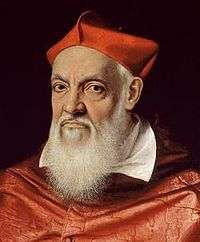Giovanni Ricci (bishop)
Giovanni Ricci (1 November 1498 – 3 May 1574) was an Italian Roman Catholic bishop and cardinal.

Biography
Giovanni Ricci was born in Montepulciano on 1 November 1498, the son of Pietro Antonio Ricci.[1] Disliking his stepmother, Giovanni Ricci traveled to Rome at age 15, seeking the protection of his father's friend Tarugi, a nobleman from Montepulciano, who could not convince the youth to return to Montepulciano.[1] He later entered the court of Cardinal Giovanni Maria Ciocchi del Monte, the future Pope Julius III, as assistant to the master of chamber; he became the cardinal's master of chamber upon the death of the old master of chamber.[1] He later entered the service of Cardinal Alessandro Farnese, iuniore.[1] He was sent on diplomatic missions to the Kingdom of France and the Duchy of Burgundy, which he accomplished successfully.[1]
He then entered the ecclesiastical estate and became a protonotary apostolic participantium.[1] In 1542, he became a cleric in the Apostolic Camera.[1] He was later to serve as apostolic collector for the Kingdom of Portugal, and nuncio to the Kingdom of France and to Austria.[1]
On 25 June 1544, he was elected Archbishop of Manfredonia.[1] From 27 June 1544 to 4 March 1550, he was nuncio to the Kingdom of Portugal (though he was unable to enter Lisbon until September 1545.[1]) On 20 February, 1545, he was transferred to the see of Chiusi, though he was allowed to retain the title of archbishop ad personam.[1]
Pope Julius III made him a cardinal priest in the consistory of 20 November 1551.[1] He received the red hat and the titular church of San Vitale on 4 December 1551.[1] He resigned the government of Chiusi sometime before 19 November 1554.[1]
He was a participant in the papal conclave of April 1555 that elected Pope Marcellus II; the papal conclave of May 1555 that elected Pope Paul IV; and the papal conclave of 1559 that elected Pope Pius IV.[1]
On 10 November 1561, he became administrator of the see of Montepulciano.[1] He served as Camerlengo of the Sacred College of Cardinals from 30 January 1563 until 1564.[1]
He participated in the papal conclave of 1565–66 that elected Pope Pius V.[1] On 30 January, 1566, he opted for Sant'Angelo in Pescheria, a deaconry assigned as titulus, and then, on 7 October, 1566, for the titular church of Santa Maria in Trastevere.[1] He was transferred to the metropolitan see of Pisa on 3 September 1567.[1]
On 3 July 1570, he opted for the order of cardinal bishops, taking the suburbicarian see of Albano.[1] He was a participant in the papal conclave of 1572 that elected Pope Gregory XIII.[1] He opted for the suburbicarian see of Sabina on 8 April 1573.[1]
He died in Rome on 3 May 1574.[1] He was buried in San Pietro in Montorio.[1]